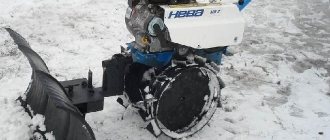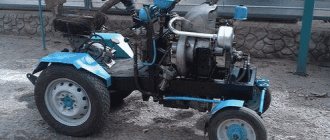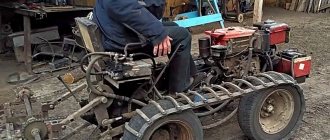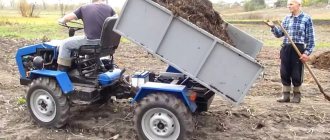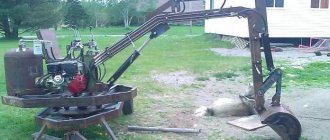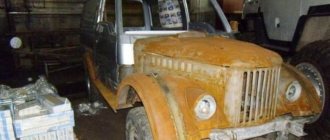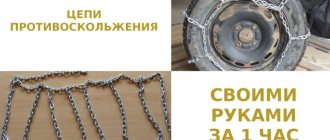Homemade shovel for a mini tractor and example for manufacturing
Many of our compatriots who live in rural areas and have large plots of land of 25-50 acres are trying to purchase a good and convenient mini-tractor, which greatly facilitates a variety of work in the village. However, in addition to the vehicle itself, various devices with the help of which the tractor can perform useful work play an important role.
So, for example, to be able to move bulk cargo or clear the yard of snow in winter, you cannot do without a special shovel for a tractor, which you can make yourself.
Everything is not as difficult as it seems
So, from the very beginning it should be noted that there is nothing complicated in the design of such a device, however, in order for a homemade shovel for a mini tractor to reliably cope with the responsibilities assigned to it, it is important to approach the matter responsibly. The first stage is drawing up a project, which should reflect all the components of the bucket, as well as the mechanism for connecting the device to the tractor itself
Next, you should sequentially select all the necessary materials and components, using all kinds of available means for this.
Making a longitudinal bucket
The shovel itself, or in the correct technical language, the blade, should be made from a piece of pipe with a diameter of at least 70 cm and a wall thickness of at least 8 mm. To do this, it should be cut longitudinally, however, not in the middle, but stepping back from the central section by ¾, as a result of which the bend of the shovel will be exactly as needed. The width of the blade is selected depending on the dimensions of the minitractor, however, as a general rule, it should not protrude beyond the external dimensions of the vehicle by more than 40 cm on each side.
Considering the high load that the blade itself will experience, it must be strengthened with additional longitudinal stops, which can be a regular 40x40 mm square pipe, which is welded just below the middle of the central part of the blade. In addition to the longitudinal ones, it is recommended to make several transverse stops - from 4 to 8 pieces, which will make the shovel extremely strong and resistant even to heavy loads. But at the bottom of the shovel along the entire longitudinal part that will be in contact with the ground, it is recommended to put on a rubber casing that will protect the blade from damage when it comes into contact with an asphalt concrete surface.
Mounting system and hydraulic cylinder for lifting
However, the shovel itself for a mini tractor with your own hands must have a good and strong connection, with the help of which it is possible to raise the blade to the desired height. To begin with, here you should weld the structure itself, which resembles the letter “A” with additional longitudinal steel elements, to which a bracket should be welded in the area of the middle jumper. As a technical mechanism that will lift the bucket, it is recommended to use a ready-made hydraulic cylinder, which is best purchased from a 2PTS-4 tractor trailer.
Assembly of the entire structure
After this, all that remains is to assemble the entire structure together and attach the homemade shovel to the mini tractor in two places - in the lower part on two through bushings through a bearing connection, and in the upper part through a hydraulic cylinder. The control of the lifting mechanism is displayed in the driver's cabin and is fixed in the form of a lever or remote control, depending on the type of lifting mechanism. Here it is also recommended to set restrictions on the lifting height in order to eliminate the dangerous height of lifting the blade, which can lead to the mini tractor tipping over.
conclusions
To summarize, we can say that in general, every person who knows how to handle welding equipment and metalwork tools can make such a ladle. So, answering the question of how to make a shovel for a mini tractor, we can confidently say that there is nothing cosmic about it and every experienced village owner will probably be able to design such a device for their vehicle.
Harrow
Manufacturer prices for harrows vary from 15 to 65 thousand rubles. For this reason, it is easier to make such a device yourself, because it will cost several times less, and will do the job no worse than the original version.
Before the land is plowed, it must be properly prepared. A disc harrow is best suited for this. The weight of the product ranges from 190 to 700 kg, the grip can be from 1 to 3 m. Several discs can be installed on the model, the tillage depth will be about 20 cm.
Harrows are divided into the following types:
- powered by a rotor;
- disk;
- dental
The first type removes soil in layers, the thickness of the cut can vary from 3 to 9 cm. This indicator can be controlled. It is also important to take into account when designing a harrow the area of land on which you will have to work. The strip width varies from 750 to 1450 mm.
When designed correctly, the blade has a sharp angle, which allows it to penetrate the soil with maximum momentum, cutting it and simultaneously destroying the roots of weeds. A disc harrow is used on dry soils, and a special star-shaped disk loosens the soil in such a unit. There can be up to 5-7 similar disks on one shaft - it all depends on the power of the engine.
A harrow with teeth is used to create uniform weeded soil. Here the protruding parts can be of very different configurations. Most often used:
- teeth;
- knives;
- squares.
- Sizes range from 20 to 40 mm. Coupling with the chassis occurs either using a spring strut or using hinges.
- The simplest harrow in design is the tine harrow. It may be enough to process the soil. In appearance, it resembles a lattice with teeth. A good hook can be an ordinary beam with holes that are placed in the tube of the towed unit, while the rod is fixed.
- Between the hook and the chassis, after the unit is assembled, dynamic chains are welded.
- The grate is made from blocks or reinforcement. Sometimes pipes with a perpendicular cross-section are used, and the walls must be at least 3.5 mm thick.
- The angle of inclination of the “teeth” should be about 47 degrees. It should also be taken into account that the created unit must fit smoothly into the turning radius.
- The “teeth” themselves are made up to 22 cm high, using steel that is used for reinforcement. The longer the “tooth”, the thicker the reinforcement should be. Sometimes the “teeth” are subjected to additional hardening and turning. Between themselves they are located with a gap of 10.6 cm.
- The arrangement of the “teeth” should be matched with the traction shaft, otherwise the harrow will crawl along the ground. Additional vibration will inevitably occur.
A blade from a gas cylinder - how to make it yourself?
One of the most common options is to make a dump from a 200 liter barrel or from a gas cylinder. Such a snow removal attachment will successfully cope with clearing the local area from compacted icy snow masses, and will save your time and effort.
As in the first case, you will need a detailed diagram that will describe in detail all the dimensions and installation locations of the main elements of the snow blower. Next, to make an auger or rotary snow blower, you will need to prepare the same materials and tools as in the first case. You don’t have to buy steel sheets and stiffeners - a cylinder or barrel will be used instead.
A snow dump for a walk-behind tractor is made as follows:
- Cut an empty barrel or cylinder into 3 parts - in the end you should be left with 3 curved segments from which you need to make a shovel;
- Weld 2 segments out of the resulting three to each other along the contour. As a result, you will receive a product 3 mm thick - this is quite enough for high-quality snow removal;
- To strengthen the lower part of the blade, install a durable steel blade. Use a drill to make 3 holes in the knife with a pitch of 10 and a diameter of 6 mm. When installing the knife on the ladle, place a rubber gasket between the elements;
- In the middle part of the installed pipe, weld a semicircle in which you make 3 holes in advance - they will be used to securely fix the rotating corners of the bucket;
- Make an L-shaped holder from another piece of pipe. Insert one end of the part into one of the holes in the semicircle, and secure the other to the walk-behind tractor frame. You can see the result of the work done in the photo.
A ready-made snow shovel will help remove large amounts of freshly fallen and compacted snow. Thanks to the large width of the bucket, you can clear a significant area, saving your time and effort.
For better cleaning of the local area, a sweeping brush can be installed on the manufactured dump. It should be secured directly behind the bucket using bolts. If you want to use this element, then when making a blade, you need to weld 2 pipes, at least 1 m long, to its side parts. A third pipe is welded perpendicular to the pipes, and the brush itself is welded to it.
Excavator bucket
You can make a mounted excavator on a mini tractor by analogy with a front loader. The fundamental difference is the shape of the bucket, as well as the boom, which will consist of two parts.
To make the boom, you will need two square metal pipes connected to each other in the shape of the letter L. The pipe on which the bucket will be attached must be longer than the pipe attached to the tractor. A hydraulic lift is connected to the protrusion located on top - it will move the boom on which the bucket is attached. The second lift ensures the movement of the boom attached to the mini tractor. The third is responsible for the movement of the bucket itself. It can be made stationary, but for greater efficiency during excavation work you need to be able to control not only the booms, but also the bucket.
The figure shows an approximate size calculation; each specific case uses its own. Thick black lines are hydraulic lifts.
The bucket itself differs from the front loader in size - it must be narrower and stronger, since it will have to blast the ground. For manufacturing, you can use sheet metal with a thickness of 6 mm; it is important to firmly weld the pins to loosen the earth. In general, this unit should be more massive, unlike a loader bucket.
Making a shovel without a lifting mechanism
The design of attachments will be much simpler if the blade frame is fixed in one position, but the mini tractor blade can rotate left and right.
Fixing the hitch is done as follows:
- An iron disk with a diameter of 15 centimeters is welded to the shovel;
- Several holes are drilled on the disk for convenient use. Optimally - three holes;
- To fix the shovel, an L-shaped pin is inserted into the holes to hold the entire structure;
- An extended handle is attached to the bucket;
- The bolts on the structure are tightened and fixed;
- The finished structure is painted.
A ready-made homemade canopy can not only remove snow. In summer, a mini tractor with a blade can be used as a bulldozer to level the soil. The shovel can be replaced with a brush for cleaning the area. The operating principle of factory shovel blades is the same, but their design is not reinforced, and therefore cannot boast of reliability and durability.
Required Supplies
When creating equipment for snow removal with your own hands, you will need different materials and tools. Therefore, take care of this in advance so as not to be distracted during the manufacturing process:
- profile pipe;
- conveyor belt;
- bolts and nuts;
- spray paint;
- chains;
- pliers;
- welding machine;
- screwdrivers and hammer;
- vice;
- file;
- Bulgarian;
- a set of keys;
- drill;
- electric hacksaw.
Having all this at hand, you can quickly make a snow blower for a walk-behind tractor with your own hands. But don’t forget that you also need the right scheme. This will be the key to a proper homemade blade.
How does a blade work?
The blade is mounted on a subframe made of a steel profile, fixedly attached to the tractor frame.
To change the position of the structure and press the working edge to the ground, a 2-way hydraulic cylinder, controlled by a spool valve, is used.
Oil is supplied under pressure by a gear pump driven by an engine.
The tool has a rotating unit that allows you to place the knife at an angle to the longitudinal axis of symmetry of the machine (the position is changed manually or with a separate cylinder).
Design process
If there is no experience and technical skills in assembling various devices, then the work will be difficult to do and will take a lot of time.
But if you stick to the plan, follow the dimensions indicated in the drawing, and work correctly with welding, the equipment will turn out to be of high quality.
The loader is assembled in stages: first, the base is created, then the boom and bucket. Manufacturing of parts and assembly process:
- The basis. To form the base of a homemade front loader, use steel corners or square pipes. The base must be strong and rectangular in shape. It is mounted on the canopy with the bottom side so that its edge protrudes slightly forward. The hydraulic cylinder will be mounted in the center of the frame. An additional triangle made of pipes is mounted under it. The spacer and hinge joints for the boom are located at the top of the base.
- Arrow. The boom is assembled from metal profiles. Their angle should correspond to 30°. The ends of the frame and hydraulic cylinder are mounted at the top of the structure. A cylindrical hinge is installed at the center point of the boom if a mini-loader is assembled. Movable segments are attached to the hinge, which are connected by cylinders and crossbars. Sometimes a large channel is used to make an arrow, but a more reliable design is obtained based on two contours.
- Ladle. The product is assembled from one large steel sheet or several small ones. To do this, rectangular blanks are cut out and welded together so that the front part is located at a slight angle. The length of the boom must be maximum 2 m longer than the loader, otherwise it may tip over. To prevent the homemade product from turning over during operation, this part is equipped with a sinker.
- Assembly process. Steel platforms that provide support for the tools are mounted on the front of the tractor under a canopy. Previously, grooves are made in them for the installation of rods. The boom is made from steel profiles. To do this, profile sections are connected at an angle of 30°, resulting in 2 contours. To make the homemade product durable, the contours are fixed with steel staples. They are installed in the center of the product and along the edges.
When making a loader for a tractor with your own hands, you need to make a protrusion at the top. To do this, a vertical support is installed on one side of the circuit and welded with a welding machine. One side of the spacer is connected to the protrusion, the other to the corner, which is located in the center of the boom.
Eyelets are made on the back side of the bucket. The boom is attached to the bottom eye. Hydraulic cylinders are secured on both sides: one side to the angle, the other to the upper eye of the bucket. Large hydraulic cylinders are transferred from the central section to a support located vertically. Hydraulic cylinders located in the front part of the structure are responsible for rotating the working part of the bucket, and the rear ones allow the boom to bend and extend. The structure is securely attached to the tractor hitch.
How to make a blade with your own hands
Steel barrel for making a blade
It’s worth saying right away that there is nothing difficult in making a blade for a mini-tractor with your own hands, but in order for everything to work without problems, you need to approach this issue very seriously. First of all, you need drawings, of which there are a lot on the Internet. They need to display all the components of the shovel, as well as the device for attaching the equipment to the mini-tractor. Next you need to collect all the required materials and parts.
A front or rear-mounted blade for a mini-tractor can be created from a piece of steel pipe with a diameter of at least 700 mm and a wall thickness of at least 8 mm, a thick-walled old barrel or a heating boiler of suitable size. To do this, you need to cut the pipe longitudinally, but not in half, but approximately ¾ of the circumference. As a result, the shovel will turn out with exactly the bend that is required. The width of the device is selected in accordance with the dimensions and power of the mini-tractor, but, according to general requirements, attachments should in no case extend beyond the outer limits of the power unit by more than 400 mm on each side.
It is important to take into account the possible large loads placed on the attachment.
That is why it is necessary to strengthen it with additional longitudinal stops, for the creation of which a square pipe with a cross-section of 40x40 mm, welded slightly below the middle of the dump, can be suitable. In addition, it is worth making 4-8 cross stops. This will give the rear mounted blade more strength and stability even under heavy loads. And the bottom of the shovel, which is made by hand and is in contact with the ground along the entire longitudinal part, should be equipped with a rubber casing. This protection will prevent damage to the grader from contact with asphalt.
The lower edge of the shovel must be reinforced with a special knife. To do this, you will need a 5 mm steel strip with a length corresponding to the working grip of the grader. Holes with a diameter of 5-6 mm and a pitch of 100-1200 mm should be drilled in the knife to secure the rubber safety strip.
What it is
Such devices have two half-frames, which are connected by movable hinges. A homemade tractor has the following advantages:
- good balancing;
- excellent maneuverability;
- small turning radius;
- high power.
These designs have 4-wheel drive, which improves stability. A homemade tractor with a breakable frame works like a mini-tractor based on a walk-behind tractor. Tractors can be factory-made, homemade, or modified using tools. Making a tractor is a complex, but interesting task that requires engineering knowledge and skills in assembling and designing moving equipment.
There are several assembly options. But there is an optimal installation method that is suitable even for novice designers. In the frame, all elements are distributed as balanced as possible. It consists of two semi-frames. You need to find out how to make its components before starting work.
In addition to the frame, it will be necessary to manufacture a steering system, install and weld the motor, think over and create the transmission and chassis. The engine must be diesel. Its power is selected in accordance with the desired performance of the tractor. Bridges can be taken from an old car. Wheels are installed with a diameter of 20 inches to improve maneuverability on difficult terrain and uneven rocky soil.
Blueprints
Before you begin assembling the structure, it is necessary to complete drawings and make calculations of the main components of the structure. The drawings should indicate the dimensions of all parts and elements and mark the places where they are welded.
Construction Tools
To make homemade products, you need components and parts from used equipment: walk-behind tractors, cars and other devices. You will need metal sheets, profile steel structures: channels, angles, screws, bolts, various types of fasteners, a screwdriver, a screwdriver, a building level, tools and small parts.
Materials and tools:
- welding machine;
- wrench;
- drill;
- disk plate;
- lathe, metal cutter, wrench.
Blade for a mini tractor - we do it ourselves, drawings, video
In rural areas, the presence of a mini tractor will not surprise anyone. Such necessary equipment allows you to cope with a number of tasks on the site, and together with attachments, its functionality increases significantly. If a cultivator on a mini tractor is a very popular canopy, then the blade is less popular. But it still remains a very popular equipment.
A blade for a mini tractor becomes necessary when in winter it is impossible to leave the yard due to a pile of snow.
In this case, connect the shaft to the mini tractor and in 5 minutes you will have a yard and road well cleared of snow.
Doing such work manually with a shovel is much more difficult, so owners of mini tractors either buy a blade or make it themselves. And now we’ll tell you how to do it.
What types of dumps are there?
A blade is an additional attachment to a mini tractor in the form of a bucket, designed for cleaning the yard, roadway, sidewalks from snow and ice. A mini tractor with a shovel is often used by public utilities and in construction, in the latter for the purpose of uniform distribution of crushed stone or sand.
Dumps differ from each other in the following qualities:
- all dumps weigh from 65 to 105 kg;
- the width can be in the range of 120 – 200 cm;
- the tractor must have a minimum power of 16 hp.
A special feature of the front shaft is that the front canopy makes it possible to use the mini tractor as a bulldozer. Thus, they can easily throw snow from the yard or level paths on the site.
It is worth noting that a minitractor with a front blade increases its weight significantly, which creates difficulties when lifting the shovel into the transport position.
Features of working with this canopy:
- We install the blade on the mini tractor.
- We choose the angle at which the work will be done (this will determine where the snow will move).
- If you intend to clear the road, then choose an acute angle. If you are going to work on large areas, then use a right angle.
How to make a shovel with your own hands?
For those who know how to handle tools and understand drawings, it will not be a problem to create a shovel for a mini tractor yourself. And we will tell you how to do this now.
Tools required for work:
- pliers;
- drill and grinder;
- old steel barrel 200 l;
- welding machine;
- keys and screwdrivers;
- strips of steel and rubber;
- fasteners (nuts, bolts, screws and rivets).
Making a shovel:
Cut the barrel into 3 parts so that you have 3 curved segments for the shovel. We weld 2 of them along the contour and as a result you get a product 3 mm thick. We reinforce the lower part of the blade with a knife. For a knife, take a steel strip 5 mm thick. The length must match the blade grip.
We drill holes in the knife (diameter: 5 - 6 mm) in increments of 10 - 12 cm. This is necessary for attaching the safety rubber strip. The width of the shovel must correspond to the power and dimensions of the mini tractor
But it is important that the blade does not extend beyond it by more than 40 cm on each side.
It is for the reason stated in paragraph 6 that we strengthen the device with additional longitudinal supports, namely square steel pipes with a cross-section of 40x40. We weld the pipes below the middle of the dump. We attach a rubber casing along the entire longitudinal lower part of the blade to prevent the equipment from coming into contact with the asphalt.
Design features of the fastening and lifting mechanism
One of the successful components of such homemade equipment is a good and strong connection. It is with its help that the blade rises to the desired height.
To create such a device, you need to weld an A-shaped structure from the longitudinal elements. And in the area of the middle jumper you will need to attach a bracket.
As for hydraulics, it is best to purchase a hydraulic cylinder from a 2PTS-4 tractor trailer.
Putting the whole structure together:
- We attach the blade at the bottom through a bearing connection in 2 through bushings.
- We connect the blade at the top through the hydraulic center.
- We bring the device control into the driver’s cabin and fix it in the form of a remote control or lever.
That's basically all you need to know about making a shovel for a mini tractor
If time and materials allow, then take into account the drawings and get to work
Believe me, such a homemade blade will not be inferior to the factory version either in quality or in convenience.
Lift
Lifting various weights (up to 800 kg to a height of 3.5 meters) can be achieved using a mechanical device. In this case, you can use the “hydraulics” of the suspension.
The design is not labor-intensive, but it is not always convenient to use. You can make another lifting mechanism.
To make a lift, you will need the following components:
- corner "8";
- sheet steel (6 mm);
- corner jumpers “4”;
- two gussets and eyelets.
- A groove is made in the rear jumper - it is needed for fixation (it is equipped with a “triangle”).
- All elements are fastened together, holes with a diameter of 24 mm are drilled for engagement. The arrow is fixed at the top point of the tip - thus creating a lever that provides the lifting height.
- The arrow is made from the angle “8”. A channel is welded along the entire length as a fastening. All joints are reinforced with welded plates. The upper part is equipped with a hook-shaped hook that bends at an angle of 45 degrees. A ball joint is attached to the other end.
- An additional guide (65 mm) is provided. Holes (4-6 pcs.) are drilled along the length so that the equipment can be secured in different operating modes.
Features and purpose
A blade for a mini-tractor is a necessary piece of equipment, the use of which is aimed at removing snow and cleaning the area during the cold season. And also with the help of a blade you can transport bulk materials without much effort. By connecting this equipment to the unit, the work can be completed within a few minutes. Procedures without dumps take several hours. A shovel for a mini-tractor can not only be purchased, but also made with your own hands, which helps save money, as well as convenient and comfortable work. You simply cannot do without a blade in the winter season, when it is impossible to leave the yard due to snow cover. In order not to waste time manually cleaning the road, you can use this attachment for the unit.
Attachment setup
Installing and adjusting the blade on a mini-tractor
Before use, the blade must be turned left or right at an angle of up to 30˚. Setting up the device ends with fixing it in the required position using cotter pins.
As a rule, the working width of the device is 1 meter and the thickness of the metal from which the grader is made is 2-3 mm. Factory dumps are made from durable high quality steel.
Self-production
to find ready-made drawings and descriptions for making one or another home-made mounted snow blower for a specific machine. After all, the unit is installed in some special way for each type of vehicle.
The mounting methods and location also differ .
Therefore, in most cases you have to:
- take drawings and methods for manufacturing a device for one machine and adapt it to another;
- draw up a drawing yourself, using a unit installed on another car as a sample.
In addition, the parts for which the drawing is drawn up are not always available.
- draw up a new drawing;
- do it the old way, making changes as you go.
You should know the three main conditions for making good mounted snow removal devices yourself: these are:
- availability of skilled and experienced craftsmen ;
- access to the necessary equipment ;
- good lawyers who can obtain the necessary documents and legalize the units.
If you decide to make some kind of snow removal equipment yourself, then make sure that all three conditions are met.
You can make the necessary equipment:
- from a not very suitable drawing;
- no drawing at all;
- looking at the finished unit.
But only such specialists as:
Motoblock. Start
The walk-behind tractor is the fruit of the late Soviet period, or rather, the era of the legendary six hundred square meters. In the mid-eighties, the Soviet government was forced to admit that the system of collective and state farms, despite being fully equipped with a fleet of modern equipment, including giant combine harvesters and agricultural aircraft, and the help of the country’s population (who doesn’t remember the “potato growing” trips?), fulfilled its main purpose function is not able to. The country was forced to purchase food from abroad.
It was decided to act on the principle “saving drowning people is the work of the drowning people themselves,” and supplying workers with agricultural products was partially entrusted to the workers themselves. Those who wished were given a plot of land with an area of six hundredths of a hectare (those same six hundred square meters).
To process even such a modest plot with the help of a shovel, a hoe, and the mother of an unknown Japanese at the end of the second millennium in the country of victorious socialism, which proclaimed the Scientific and Technical Revolution, was completely out of hand. And then it turned out that there was practically no equipment in the country capable of solving such problems. Personal plots of collective farmers, as a rule, were part of one field and were processed with one or two passes of “adult” equipment. This method was absolutely not suitable for patchwork “six-hundred” plots.
A fundamentally new type of agricultural machinery was developed, called a “motorized block” or walk-behind tractor. The “Unknown Little Animal” was a heavy motorcycle engine mounted on two coaxial off-road wheels. Working with such a unit was reminiscent of peasant labor at the beginning of the century - the plowman walked behind the horse, guiding the plow and putting pressure on it with his own weight.
Only the place of the horse was taken by a two-wheeled miracle of technology, controlled and directed using special handles. Instead of a plow, a set of attachments was used, thanks to which the walk-behind tractor could plow, harrow, sow, and mow grass. There was even a two-wheeled body with a seat, which turned the walk-behind tractor into a vehicle of unknown purpose: for movement and movement of goods around the village and the surrounding area, a motorcycle with a sidecar (another, almost forgotten relic of the past) or a car was clearly more convenient. And there was clearly no place on the highway for an incomprehensible hybrid moving at the speed of a lame mare.
Types of forklifts
If you want to find out how to make a loader for the MTZ rear linkage with your own hands, it is advisable to become more familiar with the types of this type of equipment used on the farm. Loaders of various types can significantly automate the loading/unloading processes, which makes them an effective tool when frequent transportation of goods is required.
To handle cargo, a wide range of attachments can be used, including:
- a bucket that acts as a front loader when working with bulk materials or soils;
- forks used when working with single objects;
- jaw-type gripper - used in logging, as well as for working with bulk types of cargo;
- haystack - has a limited scope of application, suitable for loading hay;
- a manipulator installation capable of moving large single objects;
- KUN, which makes it possible to work with numerous replaceable elements;
- a cargo boom with a telescopic mechanism is an indispensable tool when it is necessary to move objects to an impressive height.
Various attachments can be installed on the equipment. When understanding how to make a rear-mounted loader, it should be mentioned that such devices also differ in the type of drive into mechanical, electrical and hydraulic models. Taking into account the design features of MTZ tractor equipment, as well as the operating principle of this kind of manipulators, it should be noted that manipulators, as well as buckets, are most often used for the rear linkage.
Operating rules
During the manufacture of a front loader, manufacturers pay due attention to the safety of the operator during operation.
When using small machines, you need to monitor the overload so that the small equipment does not tip over. This can be prevented by installing protective systems.
It is also worth following simple recommendations when operating a tractor with a bucket:
- When moving, the scoop must be in the down position;
- It is important to ensure that the KUN is lifted correctly during operation;
- Special equipment (including a tractor with two buckets) must be used strictly for its intended purpose.
Types of dumps for mini tractors
This attachment is used for cleaning snow and ice in the household. Mini tractors with a shovel are actively used in the public utilities and construction industries. In the latter case, they are used to evenly distribute crushed stone or sand.
There are two main types of this equipment:
- Rear blade for a mini tractor. In this case, the equipment is rear-mounted. Starting is carried out by attaching the unit;
- Front blade. The design includes a hydraulic cylinder that launches the device. The mini tractor acts as a bulldozer with a front linkage. The weight of the machine increases significantly, so slight difficulties arise when lifting the shovel during transportation.
Dumps differ from each other in the following qualities:
- Weight ranges from 65 to 105 kilograms;
- Width from 120 to 200 centimeters;
- Tractor power with a shovel from 16 liters. With.
After installing the blade on the mini tractor, you need to select the angle at which the work will be performed. An acute angle is suitable for cleaning roads; a right angle is more suitable for working in large areas.
If you have the necessary tools and materials, you can make a snow blade for a mini tractor with your own hands.
Types and design of the device
Categories and design features of dumps for MTZ-82:
- A unit for carrying out public works, characterized by reduced weight at the expense of strength. Suitable for removing light materials (e.g. debris or soft soil), can be used on agricultural farms.
- The bulldozer-type device is made of a thickened sheet, to which plates are welded to increase rigidity. The blade is used when carrying out road work or digging trenches.
- A snow shovel is distinguished by the absence of a cutting edge; it is used for cleaning yards and roads; the tool can be used when clearing an area of soft soil.
The characteristics of the dump using the example of a municipal 2-section unit NTU-10 are given in the table.
| Parameter | Meaning |
| Width, m | 2,0-2,6 |
| Productivity, m³ | up to 340 |
| Operating speed, km/h | up to 8 |
| Structure weight, kg | 600 |
| Cost, rub. | from 135 thousand |
Additional Description
Just one tool will allow you to perform different types of tasks, such as:
- Removing freshly fallen snow and working with other bulk materials (side equipped with rubber blades)
- Carrying out light leveling work, such as: removing ice, working on soils of categories I and II (side with removable metal blades).
The universal blade has two working surfaces: one with rubber knives, the other with metal knives; if necessary, the shovel can be turned over.
Types of dumps for tractors:
- Universal hydraulic rotary blade
- Universal mechanical blade
- Municipal hydraulic rotary blade
- Municipal mechanical dump
- Bulldozer hydraulic rotating blade
- Bulldozer mechanical blade
- Bulldozer blade straight
The reinforced shovel is made of 6 mm steel and equipped with stiffening ribs. And special springs soften the impact when hitting an obstacle.
To produce rubber blade knives, a technical plate reinforced with steel cables is used, which allows the knives to be stronger and not break in the cold.
Specifications
| 2400 | 2500 | |
| - height | 795 | 895 |
| Weight, kg | 390 | 450 |
| Minimum working width, mm | 2080 | 2165 |
| Maximum working width, mm | 2400 | 2500 |
| Maximum rotation angle, ° | ±30 | |
| Lowering the shovel in a straight position below the supporting surface, mm | not less than 80 | |
| Raising the shovel in a straight position above the supporting surface, mm | not less than 320 | |
| Operating speed, km/h | no more than 15 | |
| Control | hydraulic/mechanical | |
| Can be mounted with tractors | Belarus 82.1, 82.1-23/12, 826, 892, 92P, 920, 952, 1221, 1523 and their modifications | |
| by application | Belarus 1220 |
The parts data presented on this page is for informational purposes only.
What materials and tools will be needed
If the owner intends to make a blade with his own hands, then it is necessary to prepare:
- carbon steel sheet 8 mm thick for the manufacture of the main part of the scraper;
- steel channel for assembling the frame necessary for mounting the tool;
- double acting hydraulic cylinder;
- pipelines for connecting the cylinder to the pump;
- spool valve;
- swivel connectors;
- electric drill or drilling machine;
- tool for cutting steel profiles and sheets;
- welding machine;
- measuring and drawing tools;
- a thick rubber plate (in case of assembling a snow blower);
- mounting bolts and nuts (in accordance with the documentation).
Step-by-step assembly of the structure
Rotary blade assembly sequence:
Blade design for tractor
- To make the main part of the bulldozer, a steel sheet of the required blade size is cut out, and then it is given the optimal shape. The width of the shovel should not exceed the dimensions of the tractor by more than 400 mm on each of the two sides.
- Two supports are created , to which stiffening ribs from plates are welded, and a hinge joint is installed at the bottom. The supports will be connected to the cross beam, and the entire structure will be bolted to the side members. A hinge is welded to the front of the beam for attaching the hydraulic cylinder.
- A triangular semi-frame is made from two beams , on top of which a lifting hydraulic cylinder is installed. On the outer sides of the beams, in the middle of each, one hinge is attached.
- The shovel is connected to the half-frame with two hinges. The first hinge is installed at the level of the hydraulic cylinder, and the second is 200 mm higher on a special support.
- Hydraulic cylinders are installed parallel to the subframe. Attachments for them are made to the blade at a distance of 1/3 from the center on both sides. Rotating the blade provides greater functionality to the bulldozer.
A simpler method, if the bulldozer does not require adjustment of the blade position, is a fixed mount, when instead of hydraulic cylinders, two pipes are welded to the blade on the frame.
Sprayer
The sprayer is usually made of two wheels. A container with fuel and a pump are placed on the block. Water is poured into the canister. You will also need nozzles and a hose. Sprayer differentiation:
- dispersed spraying - droplets in the form of fog cover the soil and agricultural crops with an evenly thin layer;
- jet spraying - usually used for the root system.
